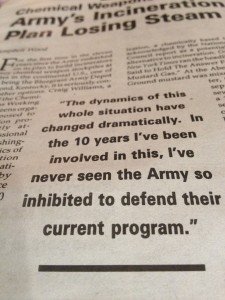Ace August 1995
by CAMPBELL WOOD
For the first time in the eleven years since the Army embarked on its plan to build incinerators to destroy chemical weapon stockpiles at eight sites in the continental 

Craig Williams, a member of the Chemical Weapons Working Group, a citizens organization opposed to the incineration program, recently attended congressional hearings in Washington. “The dynamics of this whole situation have changed dramatically,” he said by phone from his office in Berea, Kentucky. “In the ten years I’ve been involved in this, I’ve never seen the Army so inhibited to defend their current program.”
The fiscal ’96 budget is in the making, and the mushrooming cost of the Army’s incineration plans has put that program in a dimming light. Projected to cost $1.7 billion in 1985, the program is now projected at $11.7 billion, and likely more. Officials are reconsidering transportation of chemical munitions from the scattered sites to Tooele, Utah, and possibly another site, maybe in Alabama, where another incinerator would be built. But the scenario of transporting the chemical weapons is complicated by the crossing of state lines with lethal cargo.
“The Chemical Weapons Working Group doesn’t advocate moving of munitions to any facility for incineration,” says Williams. The group’s position is that incineration should be abandoned and that a closed-loop technology — a contained process — should be developed and used to safeguard the environments and the communities surrounding the stockpiles. Their stance may be gaining support from recent research conducted by the Army itself.
In September of 1994, Congress allocated $45 million for the study of neutralization, a chemically based technology acknowledged by the National Research Council report as a potential adjunct or alternative to incarceration. On May 14, the New York Times ran the headline, “Sludge is said to hold the answer for disposal of mustard gas.” At the Aberdeen proving Ground, mustard was mixed with hot water, then mixed in a separate tank with sewage sludge. Over a 10 day period, the sewage bacteria fed on the chemicals, breaking down the mustard gas into safe by-products. This was accomplished in treating one pint of mustard. The researchers are preparing to test the process on 25 gallon batches of mustard, said Lieut. Col. Steven M. Landry, a chemical engineer and a manager of the project. The Army intends to decide in July of 96 whether or not to build a pilot plant.
Success has also been met in neutralizing the nerve agent VX in room temperature water. Dr. Yu Chu Yang, a civilian scientist and member of the team of 200 private and government scientists working on the neutralization research, published a technical article in the May issue of Chemical and Industry. In it she states, “Neutralizing chemical weapons by simple chemical reactions may be a convenient and cost effective way of disposing of these compounds.”
With such encouraging results emerging from nine months of neutralization research, there arises the question as to whether Congress will increase funding to that work. Will Congress finance the construction of new chemical weapon incinerators?
“Funding is another question says Williams. “The good news is that there’s a new level of scrutiny here, and Congress is no longer just issuing blank checks based on the misrepresentation of success with the current program.”








